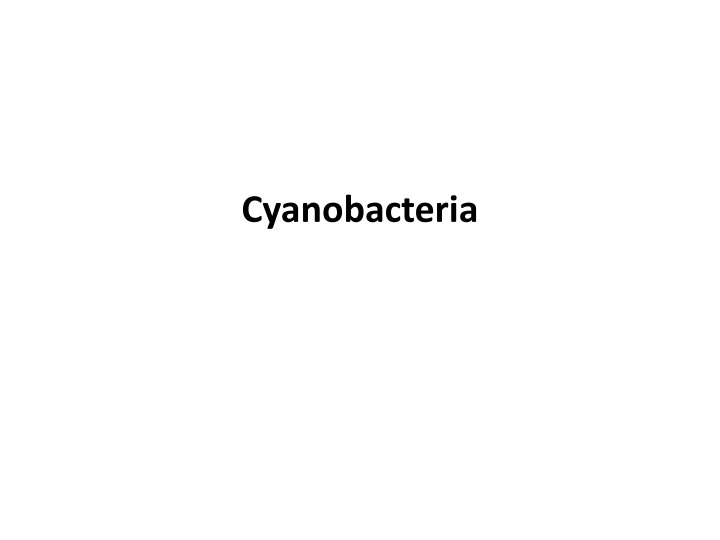
Cyanobacteria
Cyanobacteria, commonly known as blue-green algae, are autotrophic organisms found in various aquatic environments. They can exist as colonies, filaments, or single cells and exhibit unique characteristics such as photosynthesis, filament movement, and gelatinous capsule production. Their cell structure is primitive, consisting of a cell wall, chromoplast, and protoplast with a peripheral pigmented region. Explore the diverse forms of cyanobacteria and learn about their intriguing biological features.
Download Presentation

Please find below an Image/Link to download the presentation.
The content on the website is provided AS IS for your information and personal use only. It may not be sold, licensed, or shared on other websites without obtaining consent from the author. If you encounter any issues during the download, it is possible that the publisher has removed the file from their server.
You are allowed to download the files provided on this website for personal or commercial use, subject to the condition that they are used lawfully. All files are the property of their respective owners.
The content on the website is provided AS IS for your information and personal use only. It may not be sold, licensed, or shared on other websites without obtaining consent from the author.
E N D
Presentation Transcript
Cyanobacteria Commonly known as blue-green algae. Autotrophic (Photosynthetic). Contain chlorophyll a, phycocyanin (blue) and phycoerythrin (red). They live in aquatic environments including oceans, ponds, lakes, tidal flats, and moist soil. They exist mostly as colonies and filaments and sometimes as single cells.
Some filamentous forms can move. For example, filamentous forms such as Oscillatoria sp. and Nostoc sp. rotate in a screw like manner. Produce gelatinous capsules which are often lighter than water and therefore help keep the algae up near the surface of the water. Reproduction in by fission. Prokaryotic cell. Lack chlorophyll b. The photosynthetic product is stored in their own form of starch, which is similar to animal glycogen.
Forms of Cyanobacteria 1. Unicellular or aggregate e.g. Gloeocapsa sp
2. Colony MicrocystisLab.jpg (147108 bytes) e.g. Microcystis sp
3. Filamentous forms a). Unbranched e.g. Anabaena sp
3. Filamentous forms b). Branched e.g. Stigonemasp
Cell structure a) cell wall b) protoplast. The cell structure is very primitive. Each cell is composed of two parts: Cell wall Chromoplast The cell wall is composed of 2 layers: Central body The inner layer of which is thin and firm composed of peptidoglycan. The outer layer of the wall is thicker and gelatinous known as the sheath and mainly constituted of pectic compounds.
The protoplast consists of 2 parts: peripheral pigmented (coloured) region surrounding a colourless central region. It contains the blue pigment phycocyanin together with chlorophyll and known as Cell wall chromoplasm. Chromoplast Central body The colourless inner region (central body) contains several chromatin granules (DNA) which represent a primitive type of nucleus that lacks nuclear membrane and nucleoli
Nostoc Grows in water and on damp soils. Unbranched filaments with barrel-like cells. Certain enlarged cells appear at intervals, which are known as heterocysts . Its transparent and thick walls. The whole filament is surrounded with gelatinous material. Nostoc
Nostoc Each two heterocysts delimit in between , a number of cells called hormogonia. In most cases clusters of filaments are grouped together in the form of gelatinous masses. Nostoc
Reproduction 1. Vegetative reproduction. 2. Asexual reproduction. A) By fission. B) By Akinetes. Sexual reproduction is not known.
1- Vegetative reproduction. By fragmentation Filament breaks into fragments. Each gives rise to a new filament. Usually fragmentation occurs at the heterocysts This fragment is capable of creeping movements in the gelatinous sheath until it escapes and grows into a new filament.
2. Asexual reproduction. A) By fission. A constriction is formed in the middle of the cell extends from the surface inwards towards the center Division into two cells leads to the increase in number of cells per filament without production of a new one.
2. Asexual reproduction. B) By Akinetes vegetative cells AkineteHeterocystLMHigh300Lab.jpg (15127 bytes) enlarge in size become rich in food materials and form a thick wall These akinetes are yellow or brown in colour and they are very resistant to un-favourable conditions When the conditions are favourable the akinetes germinate into new filaments.
Importance of Cyanobacteria Nitrogen fixation Can be used as food (Japan, Chad, and China) Can pollute the water source (Lake). High concentration may cause fish toxicity and other microorganism.











